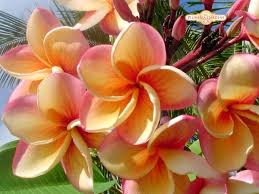Another nice flower post you made.This is very popular in some part of the world.
Plumeria (/pluːˈmɛriə/) is a genus of flowering plants in the dogbane family, Apocynaceae.[1] Most species are deciduous shrubs or small trees. The species variously are indigenous to Mexico, Central America, and the Caribbean, and as far south as Brazil, but are grown as cosmopolitan ornamentals in warm regions.[2][3] Common names for plants in the genus vary widely according to region, variety, and whim, but frangipani or variations on that theme are the most common. Plumeria also is used directly as a common name, especially in horticultural circles.
Description-Plumeria flowers are most fragrant at night in order to lure sphinx moths to pollinate them. The flowers yield no nectar, however, and simply trick their pollinators. The moths inadvertently pollinate them by transferring pollen from flower to flower in their fruitless search for nectar.
Plumeria species may be propagated easily by cutting leafless stem tips in spring. Cuttings are allowed to dry at the base before planting in well-drained soil. Cuttings are particularly susceptible to rot in moist soil.
There are more than 300 named varieties of Plumeria.
Etymology and common names-The genus is named in honor of the seventeenth-century French botanist Charles Plumier, who traveled to the New World documenting many plant and animal species.[5] The common name "frangipani" comes from a sixteenth-century marquis of the noble family in Italy who claimed to invent a plumeria-scented perfume,[6] but in reality made a synthetic perfume that was said at the time to resemble the odor of the recently discovered flowers.[7] Many English speakers also simply use the generic name "plumeria".
In Persian, the name is yas or yasmin.In Bengali the name is "Kath Golap", in Hindi, champa, in Gujarati language, "Champo", in Marathi chafa, in Telugu deva ganneru (divine nerium), in Meitei khagi leihao. In Hawaii, the name is melia, although common usage is still 'plumeria'. In Malayalam it is called pāla and chempakam. In Sri Lanka, it is referred to as araliya and (in English) as the 'Temple Tree'. In Cantonese, it is known as gaai daan fa or the 'egg yolk flower' tree. The name lilawadi (originating from Thai) is found occasionally. In Indonesia, where the flower has been commonly associated with Balinese culture, it is known as kamboja, in Bali especially it is known as jepun. In French Polynesia it is called tipanie or tipanier and tīpani in the Cook Islands. In the Philippines it is called kalachuchi.
In culture-In Mesoamerica plumerias have carried complex symbolic significance for over 2000 years, with striking examples from the Maya and Aztec periods into the present. Among the Maya, plumerias have been associated with deities representing life and fertility, and the flowers also became strongly connected with female sexuality. Nahuatl speaking people during the height of the Aztec Empire used plumerias to signify elite status, and planted plumeria trees in the gardens of nobles.
These are now common naturalised plants in southern and southeastern Asia. In local folk beliefs they provide shelter to ghosts and demons. The scent of the plumeria has been associated with a vampire in Malay folklore, the pontianak; frangipani trees are often planted in cemeteries. They are associated with temples in both Hindu, Jain, and Buddhist cultures.
In several Pacific islands, such as Tahiti, Fiji, Samoa, Hawaii, New Zealand, Tonga, and the Cook Islands plumeria species are used for making leis. In modern Polynesian culture, the flower can be worn by women to indicate their relationship status—over the right ear if seeking a relationship, and over the left if taken.



This flower has a great value to some religion like hindu,buddhist.They think this flower as sacred.This is i have got for you.Article source internet.